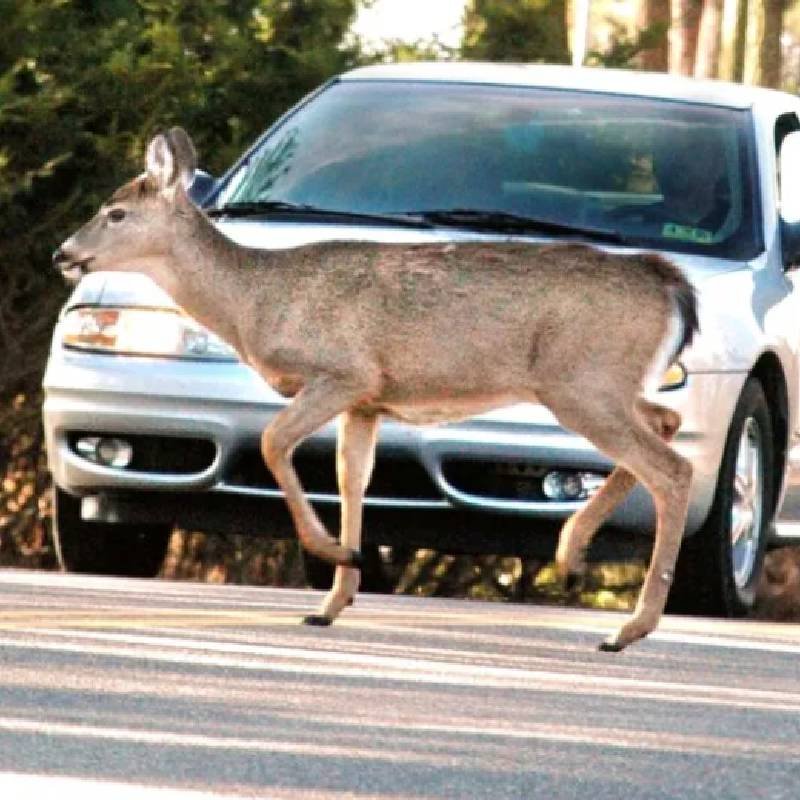Deer Run in Front of Cars? 7 Deadly Truths & Fixes!
1 million deer-car crashes yearly! Learn why deer run in front of cars and the breakthrough tech that finally stops them.
We’ve all heard the stories. A buddy swerves to miss a deer and ends up in a ditch. A family’s road trip ruined by a crash on a dark highway. Deer run in front of cars more than you think—it’s a common fear, and for good reason. It happens every day, to regular folks, on roads just like the ones you drive. The question isn’t if it might happen to you, but when—and how to stop it.
Deer-car collisions are no joke. Every year, there are over 1 million deer-related car wrecks worldwide, says the NHTSA. In the U.S. alone, these crashes kill more than 200 people a year and cost over $10 billion in damages, according to the IIHS.
Picture this: You’re cruising at 60 mph on a dark country road. Out of nowhere, a deer bolts from the trees. You’ve got about half a second to react, but your car needs 50 meters to stop. That’s a disaster waiting to happen.
So why do deer run in front of cars? Do they have a death wish? Or are we just misunderstanding their instincts? And more importantly, how to avoid hitting when deer run in front of cars? Let’s break it down.

1. Why Do Deer Run in Front of Cars? 7 Scientific Reasons
Deer aren’t trying to mess with you when they dart in front of your car. Most of the time, it’s their natural instincts clashing with the roads we built. Here are 7 key reasons why deer run in front of cars.
1.1 The Vision Trap: How Car Lights Trick Deer’s Eyes
Deer see the world way differently than we do. Their eyes are made for dim light, not bright headlights. That’s a big reason deer run in front of cars.
First, their retinas are packed with rod cells—about 90% of their eye cells are rods. These help them see in the dark, but they can’t handle bright light. When your headlights hit a deer, its pupils take up to 5 seconds to shrink and adjust, says a study in the Journal of Wildlife Management. That 5-second window? It’s often long enough for a crash.
Then there’s the “light confusion” thing. Deer sometimes mix up car lights with other stuff. A University of Wyoming study tracked deer and found 23% of deer-car collisions happen during a new moon (when it’s darkest). Why? Deer might think headlights are reflections off water—a resource they’re always hunting for. So when they see those bright beams, they run toward them, not away.
1.2 The Hearing Gap: Why Deer Often Don’t Hear Your Car
You’d think a deer would hear a car coming from a mile away. But their ears aren’t tuned to engine noises, which is another reason deer run in front of cars.
Deer hear best in the 1-8 kHz range, according to Cornell University research. Most car engines make low-frequency noises—below 1 kHz. That means deer often don’t pick up the sound until it’s way too late.
What about deer whistles? Those little gadgets that stick on your car and make high-pitched noises? A Wisconsin Department of Transportation report tested them. Only 38% of deer react to them. For the other 62%, the sound either doesn’t register or just doesn’t scare them off.
1.3 Mating Season: Hormones Turn Roads into Danger Zones
Deer act way different during mating season—and that’s bad news for drivers. It’s a top reason deer run in front of cars.
From October to December, male deer (bucks) have testosterone levels that jump 300%, says U.S. Geological Survey (USGS) data. They’re too busy chasing females to check for cars. USGS tracked deer with satellite collars and found bucks cross roads twice as much during this time.
Then there’s spring. From May to July, young deer (fawns) start exploring on their own. The National Park Service tracked fawns with GPS and found 67% of their crashes happen because they mess up how fast cars are going. They’re still learning—and roads don’t cut them slack.
1.4 Our Roads Are Invading Their Homes
Deer didn’t used to live this close to cars. But as we build more roads, we’re splitting up their habitats. This invasion is a major reason deer run in front of cars.
The World Wildlife Fund (WWF) made a model to study this. Every mile of new road breaks up 12% more of a deer’s habitat. To find food and shelter, deer now have to cross roads 1.7 times more each day than they did 50 years ago.
1.5 Winter Salt Lures Deer to Roads
Winter makes deer-car collisions worse. Here’s why: many states use salt or de-icing chemicals on roads. These make roadside grass taste better to deer—like a salty snack.
The Minnesota Department of Transportation found deer-related crashes spike 40% in winter. Deer are drawn to these treated areas, making them more likely to run in front of cars when you least expect it.
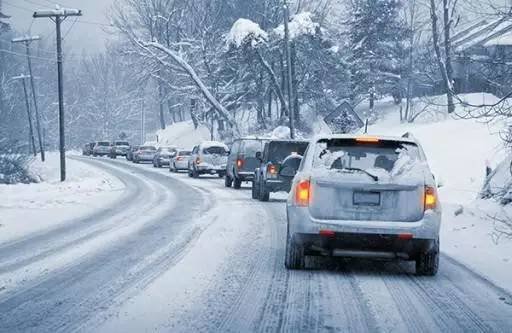
1.6 Herd Mentality: Following the Leader Into Danger
Deer are herd animals, and that instinct can get them killed. It’s a common reason deer run in front of cars.
Researchers from the Journal of Mammalogy used drones to watch deer near roads. When a lead deer starts crossing, 81% of the herd follows—even if a car is coming. They trust their leader, even when that leader makes a deadly mistake.
1.7 Dusk and Dawn: Peak Activity Times
Deer are most active at dawn and dusk. That’s when many people commute to work or head home. This overlap is a big reason deer run in front of cars.
Low light during these hours makes it harder for drivers to spot deer. And deer, already on the move, are more likely to dart into roads without warning.
2. What Products Prevent Deer-Car Collisions? Pros and Cons
Drivers have more tools than ever to stop deer from running in front of cars. But not all products work the same. Here’s the lowdown on the most common ones, and where they fall short.
2.1 Deer Whistles
These small, cheap gadgets stick on your car’s bumper or grill. They’re supposed to make a high-pitched sound (too high for us to hear) that scares deer off.
- Pros: Cheap (usually $10-$20), easy to install, no power needed.
- Cons: Studies say they’re hit-or-miss. The Wisconsin DOT found only 38% of deer react. They also stop working at speeds over 30 mph, and wind noise can drown them out.
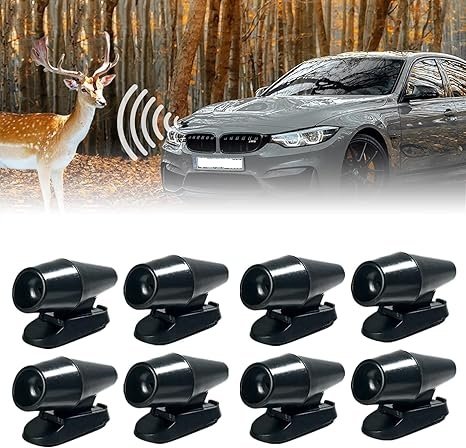
2.2 do deer whistles work? Short Answer: Rarely
If you’re wondering, “Do deer whistles work?” the data is clear: not really. Most deer don’t react to them, especially at high speeds. And when comparing deer whistles vs thermal imaging, the gap is huge. Whistles rely on sound deer often ignore; thermal imaging sees deer, even when they’re quiet. Save your money for more reliable tools.
2.3 Ultrasonic Deer Repellers
Like whistles but stronger, these use ultrasonic waves to chase deer away. Some plug into your car’s cigarette lighter; others are solar-powered.
- Pros: More powerful than whistles; some say they work at higher speeds.
- Cons: Lots of false alarms—they scare birds or squirrels but often miss deer. Rain or snow messes with the signal too, since moisture weakens ultrasonic waves.
2.4 Infrared Night Vision Cameras
Lots of dashcams now have infrared (IR) night vision, which uses infrared light to “see” in the dark. But how does thermal imaging vs infrared for deer detection stack up?
IR relies on bouncing light off objects, which fails in fog or total darkness. Thermal imaging, by contrast, detects heat—so it works even when there’s no light at all. That’s a game-changer for avoiding deer.
- Pros: Helps with nighttime visibility overall; records footage for insurance.
- Cons: Needs some light to work—useless in pitch black. In rain, fog, or snow, they only see 20 meters or less (too late to react on the highway). They also can’t tell deer apart from other stuff well.
2.5 Radar-Based Collision Warners
These use radar to spot big things (like deer) in front of your car and warn you with a beep or light.
- Pros: Works in most weather; sees farther than IR cameras.
- Cons: High false alert rates (45% according to Consumer Reports). They mix up trash bags, road signs, or even bushes with deer. And they miss deer that are standing still.
2.6 best deer collision avoidance technology: Thermal Imaging Systems
Thermal cameras pick up heat, so they can spot deer (and other warm-blooded animals) in total darkness, rain, or fog. They’re the best deer collision avoidance technology out there.
- Pros: See deer up to 200 meters away (10x farther than headlights), work in all weather, and AI models can tell deer from other things super accurately.
- Cons: More expensive than other options. They need a little setup, but modern ones are easy to install yourself.

3. Why Current Deer-Car Collision Solutions Fall Short
Despite our efforts to stop deer run in front of cars, most solutions fail. Here’s why.
3.1 Passive Measures: Not Enough to Save Lives
Passive measures are things like signs or bridges—they don’t actively warn you.
Take reflective road signs. Michigan tracked them for 5 years and found they only cut nighttime deer-car collisions by 19%. And when it rains or snows? The reflection fades, and they barely work.
Then there are animal crossings—bridges or tunnels just for deer. They sound good, but they’re pricey. A single mile of crossing can cost over $500,000. The Montana DOT checked how many deer use them: less than 30%. Most still take the risky road crossing.
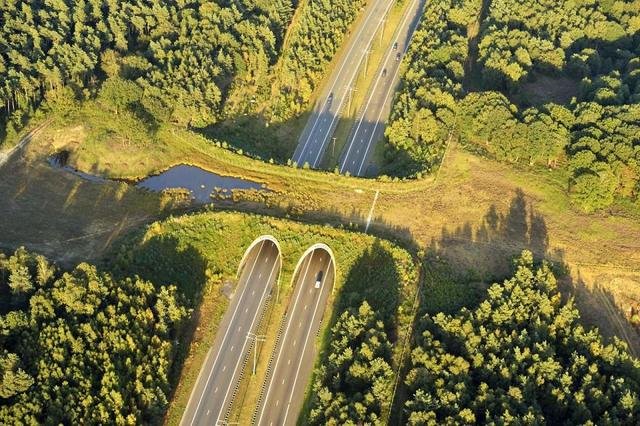
3.2 Active Warning Devices: Too Many Mistakes
Active devices try to warn you, but they’re far from perfect.
Regular infrared night vision is one example. It uses existing light to see in the dark. But a study in the Journal of Optical Engineering tested it. In rain or fog, it can only spot deer 20 meters ahead. At 60 mph, you’d hit the deer before you even see it.
Radar detectors are another option. But Consumer Reports tested them and found a 45% false alarm rate. Squirrels, trash bags, even blowing leaves set them off. And they can’t spot deer that are standing still—like one frozen in your headlights.
3.3 Driving Tips: Not Enough Time to React
You’ve probably heard tips like “watch for deer eyes at night” or “slow down in deer zones.” But do they work?
The NHTSA studied reaction times. They found “watching for deer eyes” only gives you 0.3 seconds more to react. At 60 mph, that’s nowhere near enough to stop. These tips help a little, but they don’t fix the main problem: deer often pop up too fast to avoid when they run in front of cars.
4. thermal imaging for deer detection: The Best Way to Stop Deer From Running in Front of Cars
If old solutions don’t work, what’s next? Thermal imaging for deer detection. It’s not just for action movies—it’s a game-changer for how to avoid hitting deer.
4.1 Why Thermal Imaging Beats Other Technologies
Thermal imaging sees heat, not light. That’s a big deal when deer run in front of cars.
Deer (and all living things) give off heat. Thermal cameras pick that up, even in total darkness. They work in rain, fog, and snow too. Most thermal systems can spot a deer 200 meters away—10 times farther than your car’s headlights on a dark night.
Modern thermal systems also use AI. They’re trained to tell the difference between a deer, a tree, or a mailbox. One system, tested on 200,000 images, identified deer 95% of the time. Stanford University compared it to human drivers and found the AI spots deer 1.2 seconds faster—enough time to hit the brakes.
4.2 How Robofinity InsightDrive Helps You Avoid Hitting Deer
Robofinity InsightDrive is a top choice for thermal imaging for deer detection. Its standout feature? The Robofinity InsightDrive deer detection range—up to 656 feet. That’s way farther than infrared or radar, giving you plenty of time to slow down when deer run in front of cars.
In tests in Maine, during winter—when deer-car collisions are most common—InsightDrive warned drivers about 92% of deer about to cross. Regular night vision? It only caught 31%.
Here’s how it works: The 6.25-inch screen shows heat in bright colors. Deer (and other animals) pop up in red, so you can’t miss them—even in fog. It’s tough too. IP67 waterproofing means rain and snow won’t ruin it, and it works in temps from -20°C to 70°C. Plus, it’s easy to install—no mechanic needed. You can set it up in 5 minutes.
4.3 Technology That Respects Both Deer and Drivers
The best part? Thermal imaging doesn’t just protect you. It respects deer’s instincts. It doesn’t scare them or confuse them with bright lights. It just helps you see them earlier, so you both stay safe when deer run in front of cars.
As one wildlife expert put it: “We can’t talk to deer, but we can use tech to understand where they’re going. That’s how we avoid collisions—not by fighting their instincts, but by working around them.”
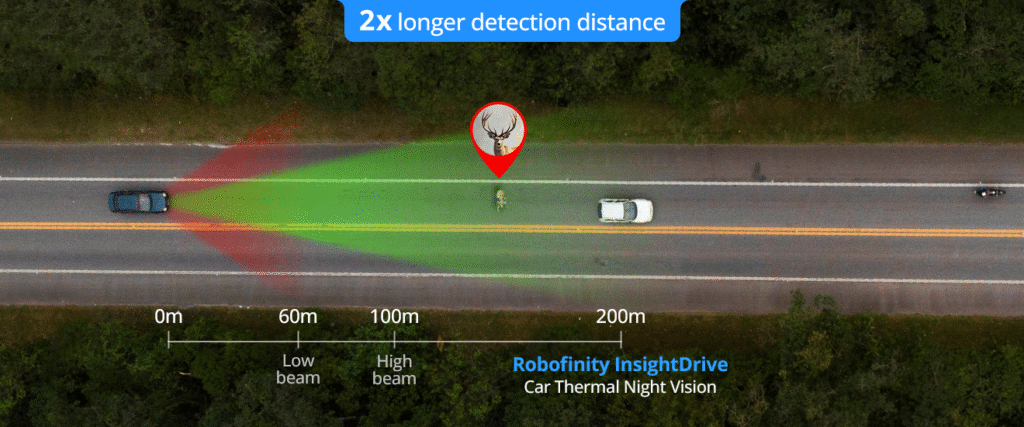
5. Conclusion: Stop Deer From Running in Front of Cars With the Right Tools
Deer run in front of cars – this is no mystery at all. It’s a mix of their biology, our roads, and bad timing. But we don’t have to accept deer-car collisions as unavoidable.
A million crashes happen every year. But with tools like thermal imaging for deer detection, we can bring that number down. Robofinity InsightDrive is one way to take action. It sees what your eyes can’t, giving you time to react before a deer steps into your path.
So next time you hit the road at night, ask yourself: Am I ready to spot a deer before it’s too late? With the right tech, you can be. After all, how to avoid hitting deer starts with seeing them early—before deer run in front of cars.
Don’t wait for a close call. Explore Robofinity InsightDrive’s thermal imaging specs to avoid deer collisions—visit https://robofinity.com/ to see how it fits your car and keeps you safe.

